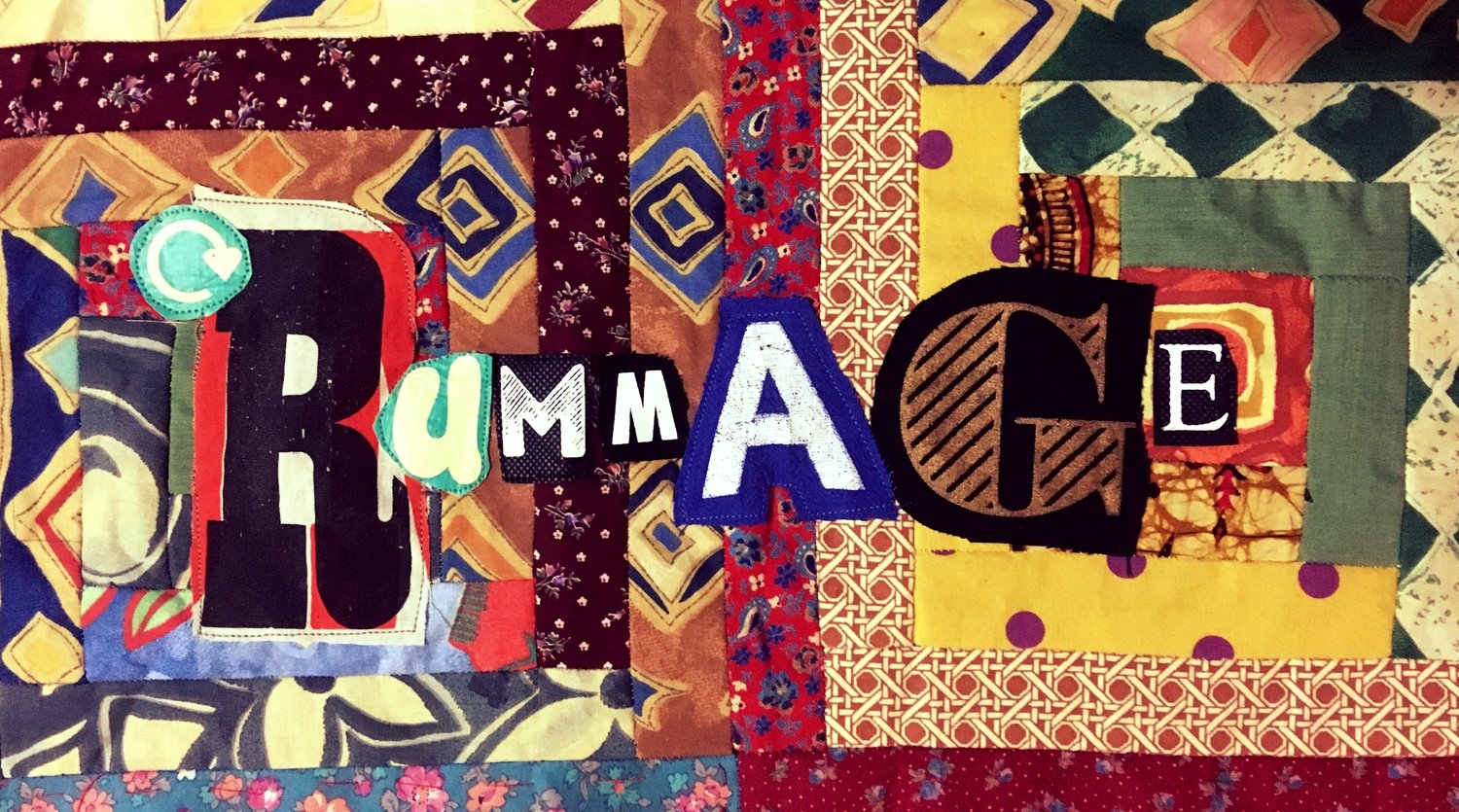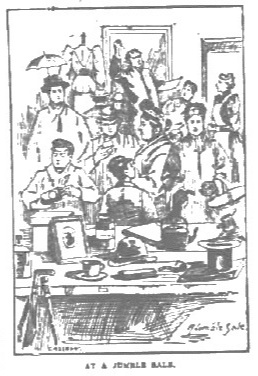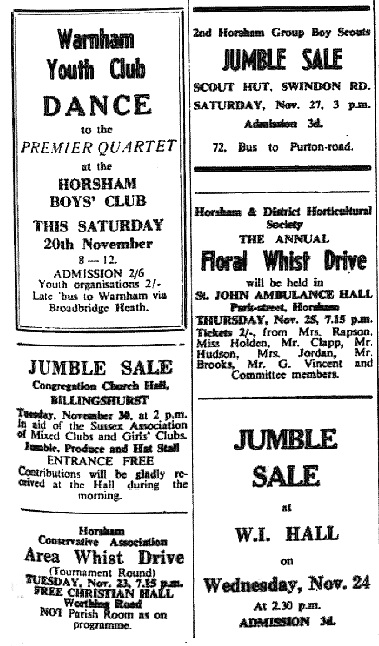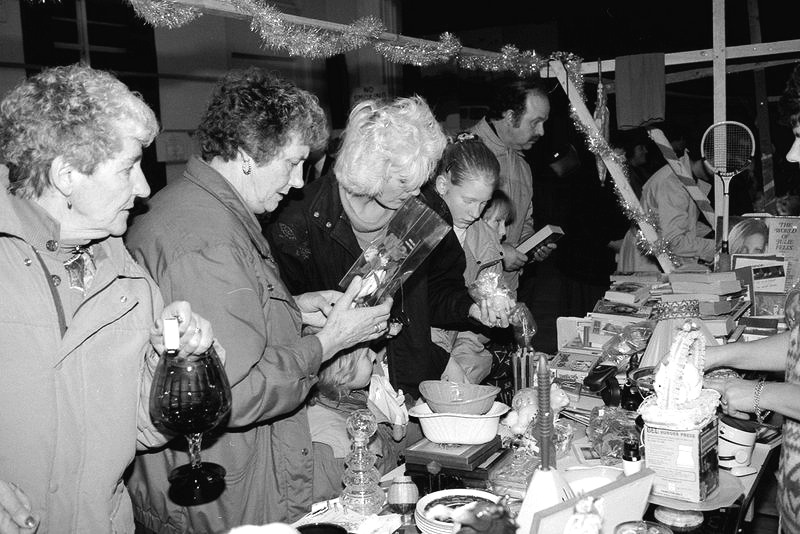Hat's Off to the Jumble Sale
Towards a History of the Jumble Sale
Although the moral ideas that drove them were much older, jumble sales were a creation of the 1880s. Contemporary newspaper reports suggest that they had become popular by the end of that decade. Historians have shown little interest in such events, but they are often revealing for the light they shed on social attitudes to second-handedness, status, and charity.
Members of the congregation of a Surrey church held a ‘Jumble Sale of Odds and Ends’ in February 1889. Although they were credited by reporters with the coining of the name ‘jumble sale’, this was inaccurate. In fact, members of a Northamptonshire church had pipped them to it the month before, holding a jumble sale to pay for church paraphernalia. (‘Wollaston’, Northampton Mercury, 5 January 1889, 7; ‘Miscellanea’, St James’s Gazette, 25 February 1889, 12). The phrase ‘Jumble Sale’ had also been used the year before in some parish magazines (see: Vivienne Richmond, ‘Rubbish or riches? Buying from Church jumble sales in late-Victorian England’, Journal of Historical Research in Marketing 2:3 (2010), 327-41).
Hats seem to have been an important attraction from an early date. At one jumble sale held in 1892, one man purchased nineteen, setting himself up with headgear for life (‘Jumble sale’, The Graphic, 19 November 1892, pp. 616, 619).
North Devon Gazette (31 January 1893), p.2
The events were often organised by clergymen of all denominations to relieve poverty in their parishes, ‘to enlist the aid of those not in need for those deeply distressed.’ A report in a Devon newspaper describes how the houses of the more well-to-do had cupboards and corners cluttered with ‘articles of dress, cast-off utensils, and all manner of heterogeneous odds and ends’. These items were gathered by the clergy ‘for sweet Charity’s sake’, and sold in jumble sales run by parishioners ‘interested only in getting as much as they can for the church funds’. The poor were thought to benefit by obtaining ‘good bargains for a few coppers, for the cast-off rubbish of gentlefolks’ houses’. This ‘rubbish’, it was thought, might prove to be ‘something to be used and appreciated in a humbler abode.’ Interestingly, this account also reveals that organisers of parish jumble sales made strenuous efforts to prevent the local ‘general and marine-store dealer and the perambulating old clothes’ merchant’ to snaffle all the items for resale at marked-up prices in their own establishments. (North Devon Gazette 31 January 1893, p. 2)
Jumble sales continued into the twentieth century. The group pictured below are gathered in 1921 at a rather meagre looking sale. Perhaps everything had been sold by the time the photograph was taken? The sale was held in Whittington Rectory, and those pictured here are mostly women and children, all wearing hats. The ‘X’ at the back was included by the card’s sender to identify one of their relatives for the benefit of the recipient. Several other photographs from this time reveal that jumble sales were commonly held in large private grounds, estate houses and other similar venues, and that they were often meaningful social occasions in addition to being means of snatching a bargain and raising funds.
This photograph (above) shows some frenetic be-hatted rummaging at a jumble sale held in Bath’s Salvation Army Citadel in 1925. It was to raise money for the ‘Bath Society for the Promotion of Kindness to Animals’, specifically money for a new home for cats and dogs. The report of the event exclaimed that it was ‘a tremendous draw to the women of the neighbourhood.’ Hundreds queued to get in, and there was ‘quite a scramble and rush’. ‘Purchasers hustled one another to get to the front’. The sale was run by the fine ladies of the city, many of whom ‘brought their household servants to assist’. Apparently Mr Sartin, Lady Menenedez’s butler, ‘turned out to be a first-rate salesman’. Within two hours, all stalls ‘were practically cleared’. The remaining items were donated to the Salvation Army, which held its own jumble sale shortly afterwards (Bath Chronicle and Weekly Gazette 28 March 1925, p. 16).
This rather bleak postcard (below) depicts a jumble sale which probably took place in the 1930s or 1940s — the words ‘Jerome Ltd’ are printed on the reverse of the card in the font used by the company from the late 1930s. The card rather strangely implies that the event had attracted just one rummager: a behatted woman looking very determined. The sale, held in a churchyard, was presumably intended to raise funds for the parish.
Three jumble sales were advertised in the West Sussex County Times on 19 November 1954 (below) . One raised money for Boy Scouts and another for the Sussex Association of Mixed Clubs and Girls’ Clubs. One of them was held in a Women’s Institute Hall.
West Sussex County Times, 19 November 1954, p.7
The sale in Billingshurst has a separate ‘Hat Stall’. Other societies — the Horsham Conservative Association and the Horsham & District Horticultural Society — preferred to raise funds through whist drives.
Although she isn’t fond of crowded spaces, my mother cannot resist a jumble sale. They were very frequent events in my childhood, not because our family had much in the way of leisure time, but because we really did need to save money. At one, my sister Harriet and I obtained this apposite book:
In this ‘Harriet Story’, the heroine Harriet meets a boy called Billy at a jumble sale run by their mothers. They rummage through hats together. This became a firm bedtime favourite, partly because it was such a familiar scene.
Jumble sales are less common now than they were in the 1970s and 1980s. We live in the age of eBay, car-booting and Gumtree. People sell their own clutter more directly and one can go hunting for specific items armed with search algorithms. If I manage to go to an actual jumble sale these days, I usually stock up on cotton fabric for patchwork quilt making, gathering up old skirts, dresses and blouses.
Late twentieth-century jumble sale in Chatteris, Cambridgeshire © Executor of Stuart Stacey



